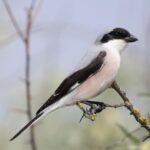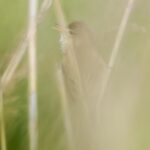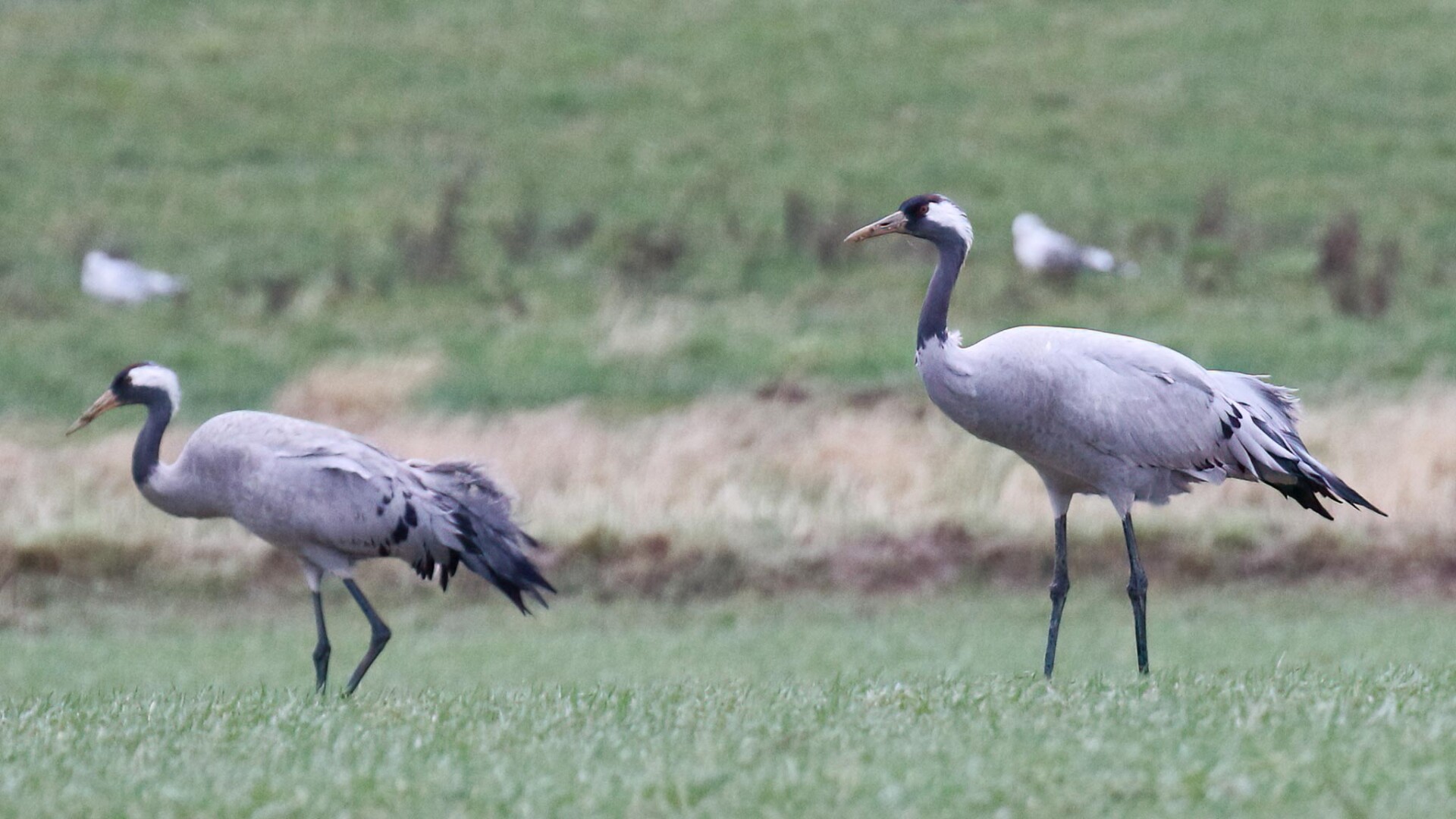Day 2 of a 3-day Winter & Brecks tour today. It was a lovely, bright and dry day with plenty of sunshine. The forecast cold E wind didn’t really pick up until later in the morning and even then was nowhere near as blustery as predicted. We spent the day along the North Norfolk coast.
With the wind lighter than forecast, we decided to head first down to the cliffs at Weybourne. As we walked along the clifftop path, several Skylarks fluttered up singing from the grass and one landed on the top of a small clump of bright green alexanders. There were a few gulls out on the sea – a Great Black-backed Gull, a few Herring Gulls and a young Common Gull – and a winter adult Common Gull flew past close in below the cliffs.
Walking up to the edge of the cultivated field next along, we suddenly realised there were several Snow Buntings hunkered down right in front of us, just a few metres in from the edge of the grass. They started feeding, picking around on the bare ground, great views. Then a Meadow Pipit flew over and they took off, whirling round before landing further back.
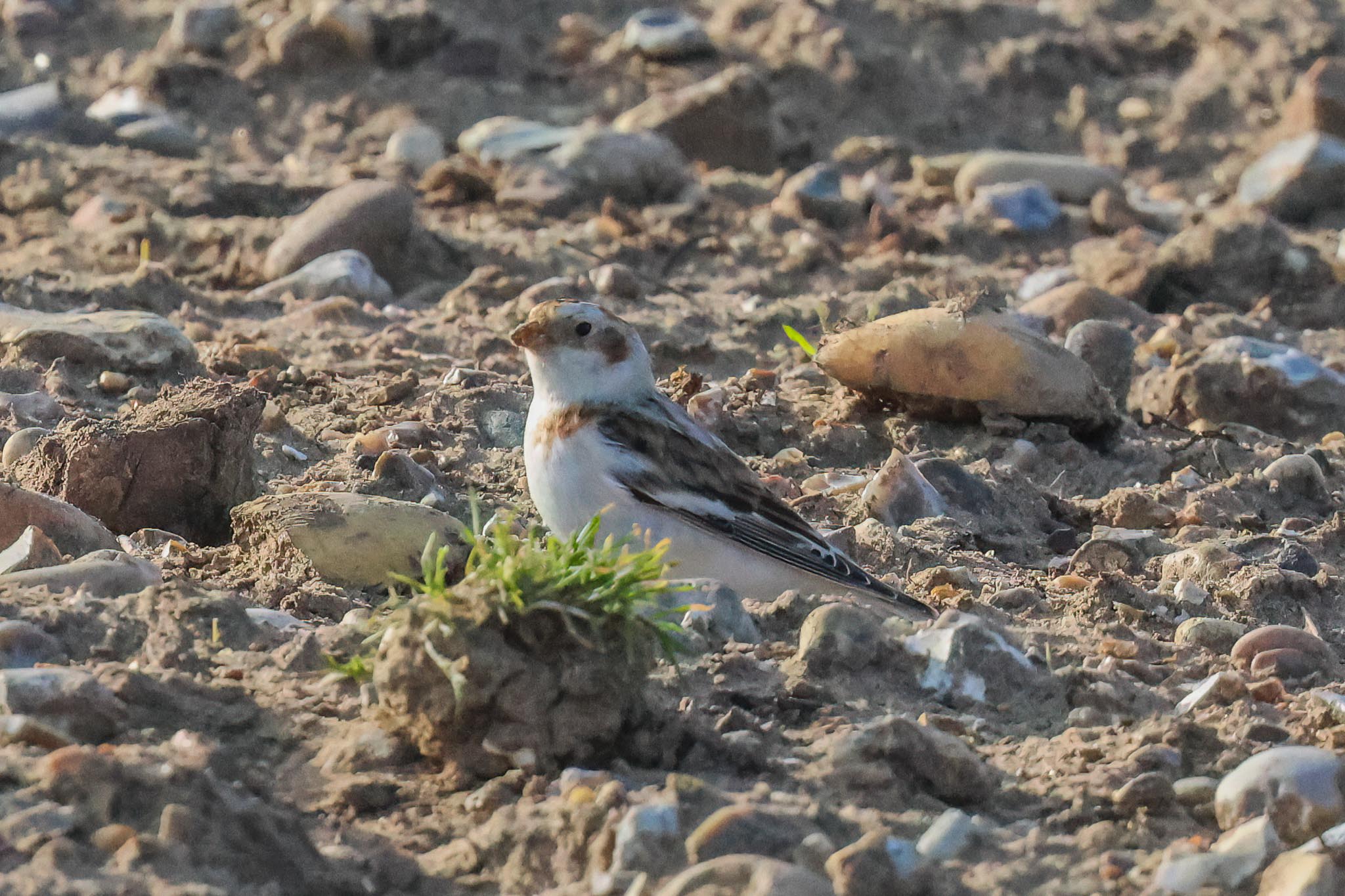
We continued to scan to see if we could find the Lapland Buntings which have been here for the last few weeks. We could see more birds further over, including more Skylarks, but we were looking into the sun from here, so we decided to walk on up the path. One of the locals who had walked on ahead of us waved us over now. He had found a couple of the Lapland Buntings but they were right over the far side of the field and tricky to see, disappearing in and out of the shallow furrows, so we got our scopes on the right area and concentrated on getting everyone onto them.
There were several Rooks and Carrion Crows along the back edge of the field too, which at times provided useful markers for the buntings! A few Curlew were feeding in the back of the block of fresh green barley nearby and a pair of Grey Partridge were feeding in front of the bank over the far side, very well camouflaged in with the clods of grey clay earth. We couldn’t find the large flock of Linnets here today, but there were still some little groups of them feeding in the field and we managed to locate a very distant Twite briefly too at one point. There were more Skylarks and Snow Buntings feeding here as well, which made it even harder to pick out the Lapland Buntings. A couple of adult Gannets flew east low over the sea behind us.
It was nice here in the sunshine this morning, but it took some time for everyone to get views of the Lapland Buntings that they were happy with. Many of the birds were now starting to work their way closer across the field so we stayed and continued to scan, eventually locating a Lapland Bunting a bit closer. Unfortunately it flew up with a couple of Skylarks before everyone could get a look at it and landed over a ridge in the middle of the field.

We decided to start walking back along the path, in the direction it had flown. As we got over the ridge, the local we had spoken to earlier now waved us over again, as he had located another Lapland Bunting out in the field. This one was quite a bit closer and easier to see and now, finally, everybody got a good look at it, before it flew again and disappeared.
We walked back along the clifftop. The flock of Curlews flew over and seemed to be heading out to sea, before turning back overhead and dropping back down into the fields. Scanning the sea, we picked up a small flock of Brent Geese flying east close in over the water, presumably starting off on their long journey back to Siberia for the breeding season. They were joined briefly by a drake Common Scoter, which quickly changed its mind and peeled away, flying back west.

Back at the minibus, we drove back west to Cley. We stopped at the Visitor Centre to use the facilities and had a quick scan from the terrace. There were lots of Avocets out on Pat’s Pool, along with Black-tailed Godwits, a flock of Dunlin and a couple of Ruff. Two Lesser Black-backed Gulls were in with the Black-headed Gulls. A Marsh Harrier swept in and out low over the reeds, landing a couple of times but mostly out of view. We could see some Brent Geese distantly out on North Scrape, but couldn’t see anything in with them. Some more Brents flew in from the direction of Blakeney and dropped down with them, but there was nothing different with them either.
The young Red-breasted Goose which has spent the winter ranging widely along the coast had reappeared at Cley a few days ago and then spent a couple of days feeding with the Brent Geese on Blakeney Freshes. It hadn’t been seen yesterday, but we wondered whether anyone had ventured out to look in the blustery wind, so we decided to try our luck there. As we drove down along Back Lane, a Brimstone butterfly flew over the road in the sunshine, our first of the year. Down by the quay, a male Marsh Harrier flew round out over the grass right next to where we had parked, having a tussle at one point with a Kestrel which had been hovering nearby. Lots of Wigeon were feeding out on grass, whistling.
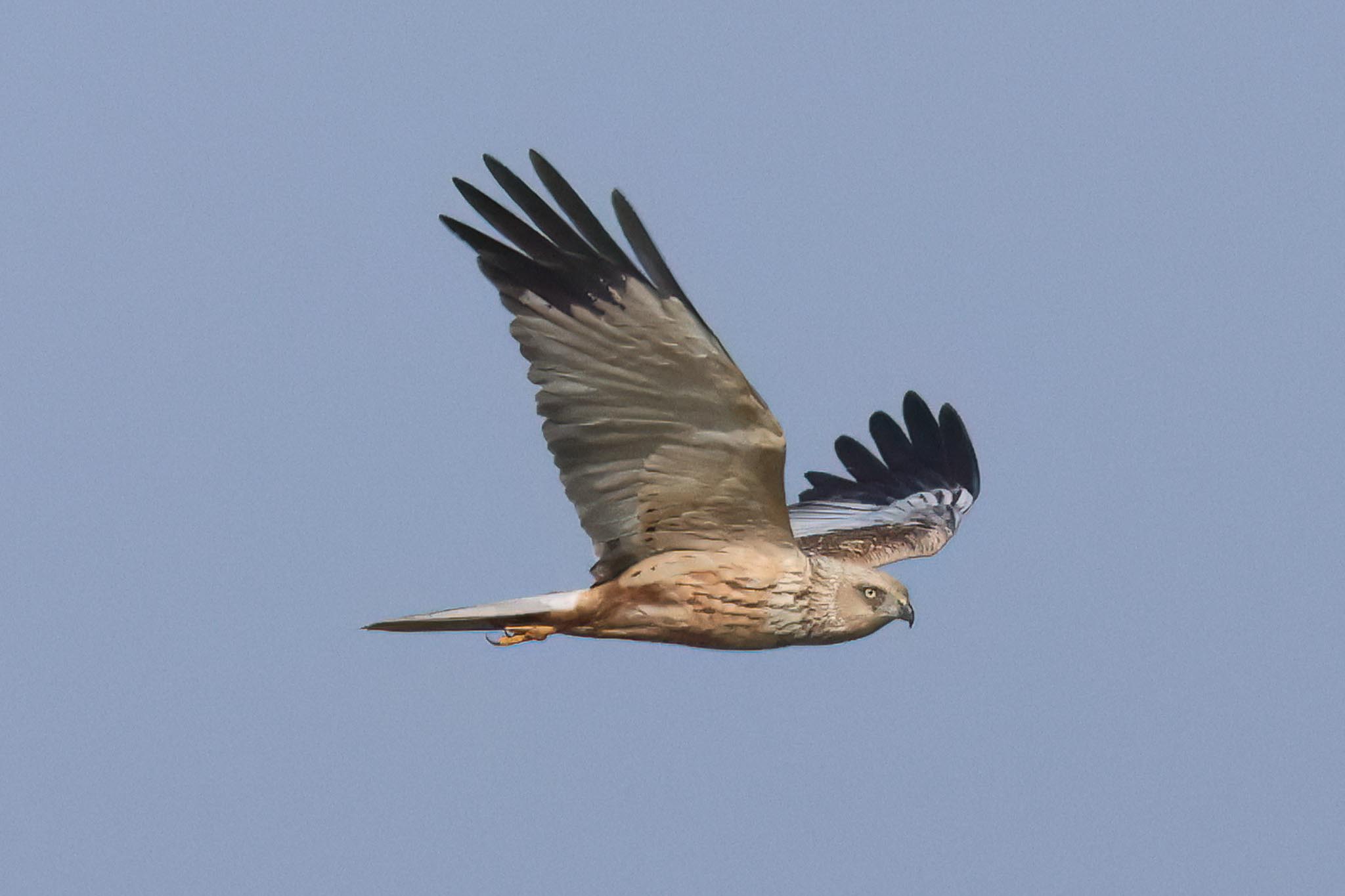
We saw a small flock of Brent Geese flying over and they dropped down with a larger feeding flock out in the middle of the Freshes. We decided to have a quick look from the top of Friary Hills, just in case the Red-breasted Goose might be in with them. A Greenfinch was wheezing away in the hedge and a Common Buzzard drifted over the trees. Up at the top, there is a great view out across the grazing marshes to Blakeney Point beyond. We could see the flock of Brent Geese clearly now and there was nothing with them. We could also see more Brents over towards the bank by the harbour, and although most of the flock were hidden behind some reeds, a Pale-bellied Brent stood out even at that distance amongst the regular Dark-bellied Brents we could see.
Our initial plan was to walk out on the harbour wall so we walked back down and past the duck pond, which is largely empty now after an outbreak of bird fly last year. Out on the bank, the wind had picked up noticeably now and it was decidedly chilly here. We walked out until we could see the Brent Geese here, but again nothing was with them either. There were a few Redshanks and Curlew in the muddy creeks and a Great White Egret flew over, dropping down out of view on the saltmarsh. It was very busy here now, too many people, everyone seemed to be out walking their dogs today! It meant as well as being cold it was very disturbed, which meant it was rather quiet for birds. We decided to try our luck elsewhere.

We drove on west and had just pulled up to scan the floods east of Stiffkey when we got a message to say that the Red-breasted Goose was back at Cley with the Brent Geese there (which would be why we couldn’t find it at Blakeney!). We did a quick u-turn and headed back. As we got to Beach Road and got out, all the Brent Geese flew up but thankfully landed again just one field back. We could just see the Red-breasted Goose from the side of the road but from up on the to of the West Bank we had good views of it feeding with the Brents. A very smart goose! A scarce visitor here, which should be wintering in Romania, and one of the highlights of the last few months here.
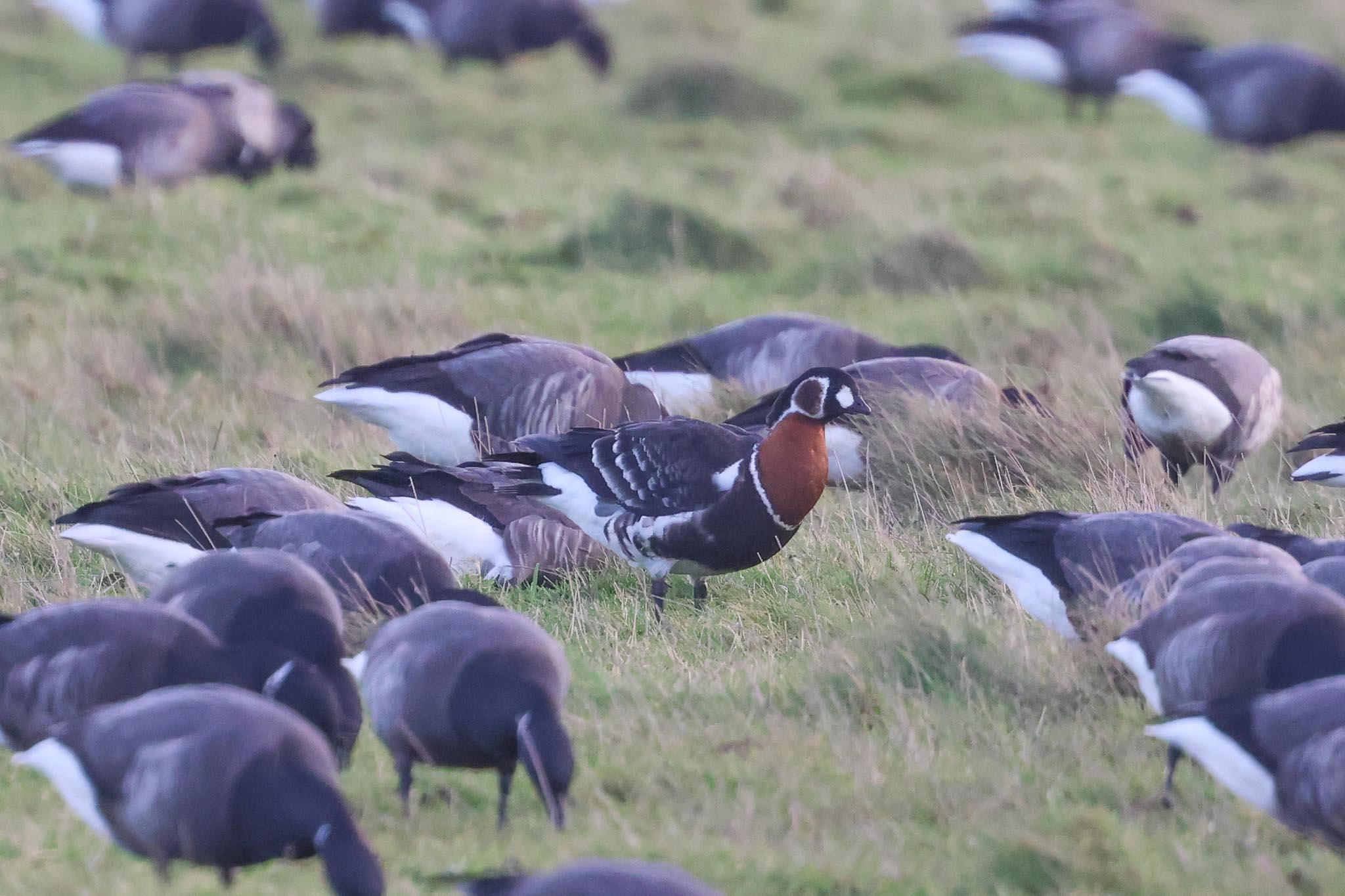
When all the geese flew up, one of the group who was looking the other way asked what was the large bird flying over. We turned round and looked up to see a Common Crane in the sky! It flew straight through without stopping and continued off east, later being tracked all the way along the coast as far as Trimingham at least. A great bonus and a proper wild bird here, the Cranes which spend the winter in The Broads often start to wander further afield on sunny days in early spring.
We drove round to the Visitor Centre for lunch. It was a bit breezy in the picnic area, particularly as all the bushes which give it some shelter have been cut right back down, but thankfully it was not too bad in the sunshine. Afterwards, we headed back west along the coast to Holkham. As we got out of the minibus on Lady Anne’s Drive, there were lots of Wigeon, Teal and Shoveler on the grazing marshes in front, along with a couple of scaly-backed Ruff.
The Shorelarks had been feeding west of the Gap this morning but on our way out through the pines we met someone coming back who told us they were not there now. So we decided to try down in the cordon instead, along the path to the east. There were several Meadow Pipits feeding on the saltmarsh as we walked past and we were almost there when we met someone else walking the other way who told us they had just seen four Shorelarks back in the cordon. Good news!
As we arrived at the fence, we saw a Shorelark scurrying towards the deeper vegetation out in the middle, so we turned towards the dunes and scanned from the fence there, but couldn’t see it now. Then we realised there were five more Shorelarks further over, closer to main path. After a quick look from here through the scopes, just in case they flew, we walked round to the other side where they were feeding. We stopped and got the scope on four of them, then noticed another Shorelark was right in front of us, just a few metres away. We had great views now, their yellow faces glowing in the low sunshine. Then the rest of the Shorelarks flew out from the thicker vegetation in the middle of the cordon and joined the five, and now we watched all thirteen feeding together.
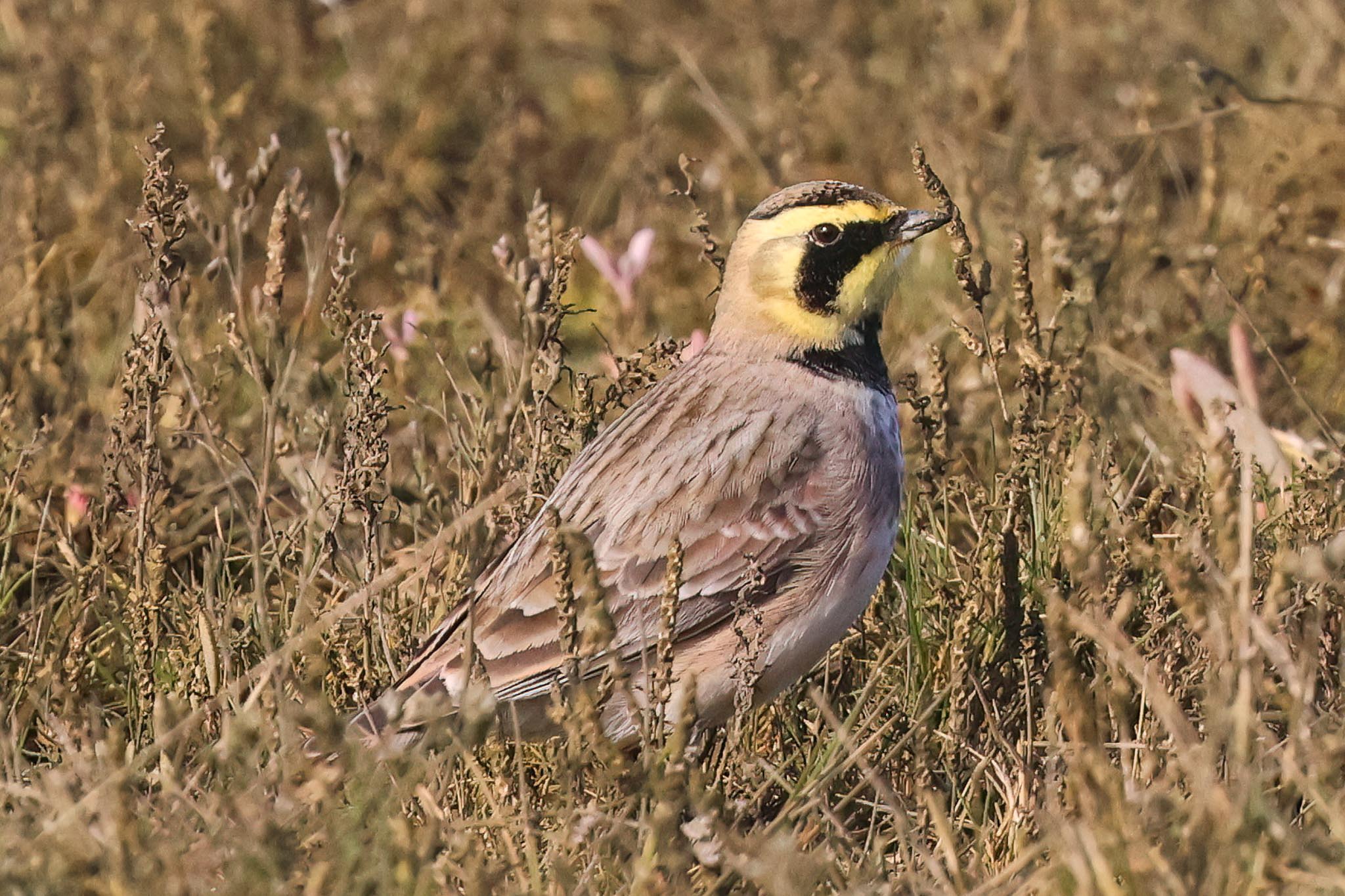
We walked on to the dunes now and had a quick look at the sea. The Common Scoter flocks were very distant in the mist – we could see long lines of black dots bobbing on the water, too far out to make out anything else in with them today. A Great Crested Grebe in breeding plumage was on the water much closer in and when three ducks flew past, we could see they were a pair of Red-breasted Mergansers followed by a female Pintail.
After walking back to the minibus, we drove round to check the grazing marshes the other side. In one of the grassy fields by the road, we could see several Barnacle Geese in with the Greylags but no White-fronted Geese here now, but at our next stop, we did manage to find some White-fronted Geese, feeding on the grass in the distance over in front of the remains of Joe Jordan hide. We could see the white surround to their bills and their black belly bars. Most of the Pink-footed Geese which spent the winter here have departed Norfolk already and headed north, but we did manage to find three very distant Pinkfeet now, over on Burnham Overy Grazing Marshes.
A distant white spot in the trees was a Spoonbill, doing what Spoonbills like to do best and sleeping – we could see its bushy nuchal crest but not its bill. Several more were even better hidden in the sallows but after a while one or two flew round and eventually one perched awake in the open so we could see its spoon.
There were several black-hooded Mediterranean Gulls on the large pool along with a small group of feeding Pintail. A couple of distant Great White Egrets were out on the smaller pools on the grazing marsh, one with a Grey Heron alongside for size comparison. Several Common Buzzards drifted overhead from the trees behind and two Red Kites circled over. Then it was time to head back for tea and cake again, but we still had one more day to look forward to tomorrow.
